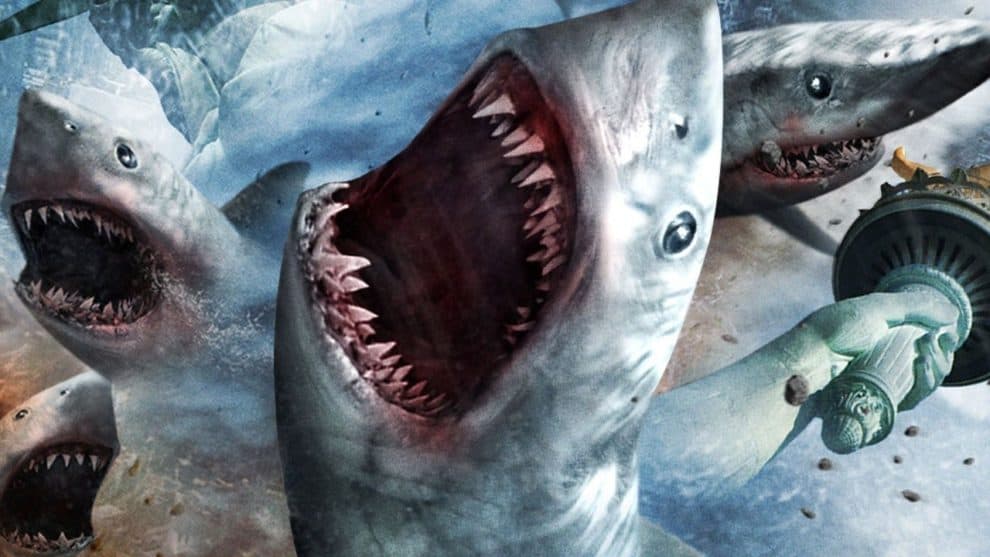
- People have been fascinated by–and terrified of–sharks for centuries.
- Unprovoked shark attacks are rare, fatal attacks even more so.
- 2018 saw a decline in shark attacks worldwide yet mainstream media hysteria continues.
Every year, SPORTSINSIDER.COM sets a variety of betting odds on shark attacks–worldwide, domestically, locally. This year, the story accompaning these odds featured the ongoing shark attack hysteria gripping Cape Cod as the perfect example of unfounded fear of something with a statistically insignificant risk. Since then, the media hysteria about sharks and the risk of attack around Cape Cod has actually increased.
CAPE COD, MASSACHUSETTS–SHARK HYSTERIA CAPITAL OF THE WORLD
Last week, I received an email from The Boston Globe with a link to a news story entitled:
FREQUENT SHARK SIGHTINGS ARE CHANGING HOW WE VACATION ON THE CAPE
My response: ‘you’ve GOT to be kidding’. To be fair, the actual story had a slightly more reasonable headline:
SUN, SAND, AND SHARKS: CAPE BEACHGOERS ARE WARY ABOUT JUMPING INTO THE WATER
Earlier this year, we wrote this about the Cape Cod shark hysteria:
The current epicenter of shark attack insanity is Cape Cod. You see, ‘The Cape’ saw a whopping two shark attacks last year including one fatality. While anyone with the slightest understanding of math realizes that this is statistically insignificant, some locals have reacted as if the beaches are under siege. Making matters worse, the mainstream media fans these flames of lunacy:
Shark Attacks Overshadow Cape Cod Tourist Season
Cape Cod Communities Taking Action to Prevent Deadly Shark Attacks
Cape Cod Surfers Train to Become Shark Attack First Responders
Shark Fever has Arrived on Cape Cod
As Summer Begins, Specter of Shark Attacks Looms Over Cape Cod
After Shark Attacks, is Cape Cod Ready For Tourist Season?
Why Shark Attacks Could Rise Around the World
So on and so forth. Despite the fact that the International Shark Attack File–one of the more comprehensive data sources on the topic–reports that Massachusetts has had 6 unprovoked shark attacks since 1837 the tone of the local media is that a beach blanket bloodbath is likely for the state. Since the two attacks last year there has been a grand total of…uh…zero…attacks in the Bay State. All the more amazing–the hysterical media reports often cite the International Shark Attack File but seldom bother to read such topics as ‘Shark Attacks in Perspective’:
“Many more people are injured and killed on land while driving to and from the beach than by sharks in the water. Shark attack trauma is also less common than such beach-related injuries as spinal damage, dehydration, jellyfish and stingray stings and sunburn. Indeed, many more sutures are expended on sea shell lacerations of the feet than on shark bites!”
There’s wall to wall ‘shark hysteria’ but you don’t see anywhere near as much coverage sea shell lacerations. While there have been a few media reports that put the true risk of shark attack into perspective–this one at Forbes is particularly good–they’re few and far between. Now, we’re supposed to believe that people are actually *changing how they live* out of fear despite the 1 in 3.7 million lifetime odds that they’ll suffer a fatal shark attack.
VOLUSIA COUNTY, FLORIDA–SHARK ATTACK CAPITAL OF THE WORLD
While Cape Cod has absolutely freaked out over sharks, the tone in an area that actually has shark attacks is markedly different. The mainstream media made a big deal over three people bitten by sharks in two days at New Smyrna Beach in Volusia County, Florida. Two were bitten on Saturday, August 3 surfing near the NSB pier. The third bite wasn’t exactly a Jaws-like battle against death:
Less than 24 hours after the first two bites, 51-year-old Peter Bourbeau was standing in knee-deep water when his right foot was bitten by what he described as a 4-foot-shark, Volusia County Beach Safety said. He told officials that he kicked the shark with his left foot, and it swam away.
The photo accompanying this article–along with many ‘shark bite hysteria’ articles is of a scary looking great white shark. That’s a good way to amp up the paranoia factor but researchers usually have a hard time discerning what species is responsible for attacks. Along the Florida Coast, the species responsible for the majority of bites is the blacktip shark–a formidable creature to be sure but not quite the monster shown in the stock photos that typically accompany shark bite media reports. Here’s what researchers say about the shoddy information people give them about the specific type of shark that bit them:
“Researchers with the Shark Attack File never know which species to attribute a majority of the bites to each year. That’s because when asked to describe what bit them, people often say it was about six feet long and “looked like a regular shark”. “
The rash of shark bites over the weekend must be unprecedented, right? Nope. In fact, there have been 5 bites in the past 8 days at New Smyrna Beach. This makes a total of 9 for the year which is a decidedly average number. In 2018, Volusia County had 9 bites reported and in 2017 they had 14. Furthermore, multiple bites on the same day while not common are far from unprecedented. Using data from the Global Shark Attack File (GSAF) Incident Log it turns out that this is the 7th time in the past decade that two bites on the same day were reported at New Smyrna Beach. It’s also the third time with at least three bites in a 48 hour period. It might be something worth mentioning in the local media but hardly a sign of an uptick in shark activity, let alone a Sharknado like apocalypse at the beach.
THE AVERAGE BEACHGOER IS AT NEGLIGIBLE RISK
The ‘shark hysteria’ media also tries to suggest (or strongly infer) that the average beachgoer is at increased risk. There’s scant statistical data to support that and particularly at New Smyrna Beach (where the overwhelming majority of bites in Volusia County are reported). 58% of all shark attacks reported worldwide have ‘surfing’ indicated as the activity during which the bite occurred. This total doesn’t include related activities like body surfing, boogie boarding, kite surfing, etc. Surfers should be aware of sharks and how to deal with them to avoid bites the same way that backcountry skiers and snowboarders learn how to deal with the risk of an avalanche. Sharks don’t randomly have it out for surfers–in fact, in the majority of cases they’re going after bait fish and accidentally nip a hand or a foot hanging off of a surfboard.
The percentage of shark bites that list ‘surfing’ or a related activity is even higher in Volusia County. That’s because New Smyrna Beach is widely considered to be among the best surf spots on the East Coast. Surfer magazine ranks it as the #4 surf town in America (the highest of any town outside of California). NSB is known for having some of the most consistent waves on the typically inconsistent Atlantic Coast. Lindsay French, who supervises the International Shark Attack File at the University of Florida, explains the reason there’s so many shark attacks in Volusia County :
“Volusia County just has the most surfers in Florida and the most people in the water, so they keep topping the chart for shark attacks. On a good day, there could be 300 surfers in the water.”
SURFERS UNDERSTAND THE RISKS
So the surfers of Volusia County are no doubt up in arms demanding something be done and writing articles about how all of the shark attacks are ‘changing how we surf at New Smyrna Beach’? Not even. Lindsay French again:
“I love dealing with the people who get bit down there. They’re so respectful of the sharks. They’ll say if they bite me I was in their territory or there was a lot of bait fish in the water. Those surfers don’t care, they just deal with it.”
Gavin Naylor, director of the Florida Program for Shark Research at the Florida Museum of Natural History, says that the presence of sharks isn’t exactly ‘breaking news’ to surfers:
“If you like to surf and you surf in this particular spot, the chances are high that you have been within 10 feet of a shark. The surfers all know this. They routinely report seeing sharks in the area. While it may be news to the non-surfing community, it is widely known to scientists and surfers.”
A surf spot report for New Smyrna Beach actually refers to sharks as one of ‘the usual hazards’ along with Portuguese Man-of War and ‘polluted estuary runout’. Not really a surprise that one of the local spots is a sandbar known as ‘Shark Shallows’.
COGNITIVE BIASES FOR FUN AND PROFIT
Now, why would the people least at risk of a shark attack–random Cape Cod tourists–be so terrified of them to the point that it changes how they live and those most at risk–surfers–have such a solid grasp of the risk factor? Several cognitive biases are at work here:
–PROBABILITY NEGLECT: This is a term coined by the brilliant Cass Sunstein that refers to the tendency people have to improperly assess ‘risk and peril’. This results in a heightened fear of events that are statistically very unlikely (eg: shark attacks) while undervaluing the risk of events with a much higher probability (eg: falling down the stairs).
–OBSERVATIONAL SELECTION BIAS: Otherwise known as ‘why people think they’re seeing sharks everywhere in Cape Cod and freaking out about it’:
“This is that effect of suddenly noticing things we didn’t notice that much before — but we wrongly assume that the frequency has increased. A perfect example is what happens after we buy a new car and we inexplicably start to see the same car virtually everywhere. A similar effect happens to pregnant women who suddenly notice a lot of other pregnant women around them. Or it could be a unique number or song. It’s not that these things are appearing more frequently, it’s that we’ve (for whatever reason) selected the item in our mind, and in turn, are noticing it more often.”
–NEGATIVITY BIAS: The brain’s tendency to pay more attention to bad news and to filter out ‘good news’ or information that contradicts the bad. While the number of shark attack incidents has shown a slow increase over the past decade or two the number of fatal attacks has dropped dramatically.
IF YOU’RE GOING TO FREAK OUT OVER SHARKS DO IT RIGHT
As you may be aware, the photo accompanying this article is from the now ‘classic’ movie franchise Sharknado. Yep, tornadoes full of sharks. People rightfully find this concept funny yet from a statistical standpoint worrying that you’re going to be killed by a shark at the beach isn’t much different than worrying about an actual ‘sharknado’. So if you’re a surfer it’s a good idea to learn about sharks and mitigating the risk of attack. If you’re just a random beachgoer you really need to relax and get a grip.
SPORTSINSIDER.COM 2019 SHARK ATTACK BETTING ODDS
SPORTSINSIDER.COM 2019 SHARK WEEK SPECIAL SHARK ATTACK BETTING ODDS









